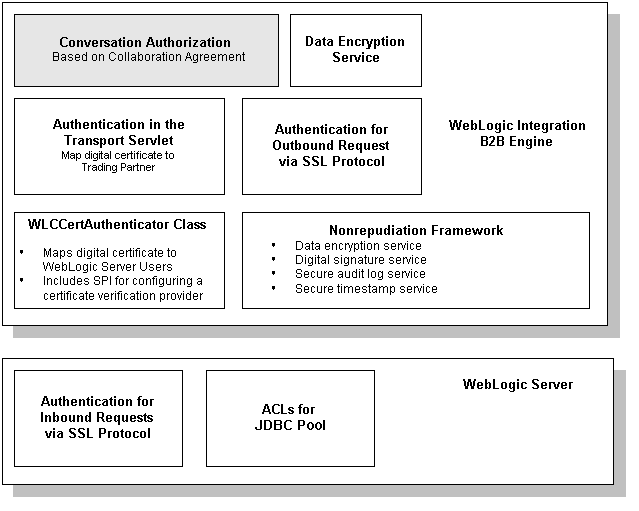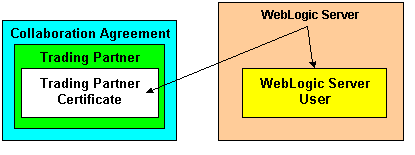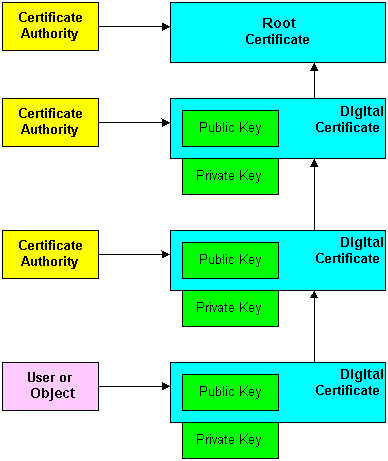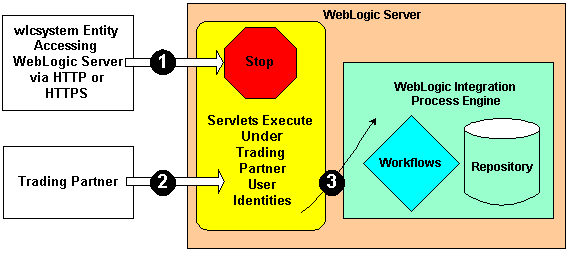


|

|
|
|
|
Introducing WebLogic Integration B2B Security
This topic includes the following sections:
WebLogic Integration B2B Security Model
The WebLogic Integration B2B security model incorporates the following primary features:
This section describes the WebLogic Server and B2B entities involved in providing the authentication and authorization features of WebLogic Integration.
WebLogic Integration B2B authentication is the process of verifying a principal's identity. Authentication is concerned with who an entity is; it is the association of an identity with an entity. Authorization is concerned with what that identity is allowed to see and do. WebLogic Integration B2B uses the following methods to perform authentication:
Authorization protects who has access to the available resources. Permission to access B2B resources is assigned through access control lists (ACLs) and roles.
For complete details about how WebLogic Server and WebLogic Integration B2B work together to authenticate and authorize principals in the WebLogic Integration B2B engine, see Authenticating and Authorizing Trading Partners.
The following figure shows the entities and features in WebLogic Server and WebLogic Integration that provide the B2B security model.
Figure 1-1 WebLogic Integration B2B Security Model
The following table describes each of the features shown in this B2B security model.
Table 1-1 Components in the WebLogic Integration B2B Security Model
For more information about the WebLogic Server security features used by B2B engine, see "Configuring the SSL Protocol" and "Defining ACLs" in Managing Security in the BEA WebLogic Server Administration Guide.
Principals, Users, and Groups
Principals are entities that need access to the B2B environment and resources. WebLogic Integration B2B principals include:
Principals are granted access to the WebLogic Integration B2B engine environment and resources through authentication and authorization mechanisms. Principals in WebLogic Integration B2B map to WebLogic Server users.
If the B2B engine can prove the identity of the WebLogic Server user, the B2B engine associates the user with a thread that executes code on behalf of the user. Before the thread begins executing code, WebLogic Integration B2B checks pertinent access control lists (ACLs) to make sure the WebLogic Server user has the proper permission to continue.
WebLogic Integration B2B supports the following types of WebLogic Server users:
Groups are sets of WebLogic Server users. Groups provide an efficient way to manage large numbers of users because an administrator can specify permissions for an entire group at one time.
Note: Because the tasks typically performed via the WebLogic Integration B2B Console requires system level privileges—for creating users, accessing MBeans, and so on—the WebLogic Server username for logging into the B2B Console is configured as a WebLogic Server system user.
About Configuring Trading Partners
When you configure a collaboration agreement in WebLogic Integration, you also specify the trading partner name bound to that agreement. To associate a user with a trading partner in the B2B Console, specify the trading partner username, which is a WebLogic Server username. WebLogic Server maps the digital certificate for that trading partner to the trading partner user at run time.
Figure 1-2 Mapping a Trading Partner Certificate to a WebLogic Server User
Therefore, when a trading partner message arrives in WebLogic Server, WebLogic Server is able to match a trading partner to a WebLogic Server user by reading a trading partner certificate, and the B2B engine authentication process may begin. About Configuring the WebLogic Integration B2B System User Please note the following about the B2B system user:
Note: When the password does not match the one specified in the fileRealm.properties file, a warning is entered in the system log. When the password for user wlcsystem does not match, the B2B engine uses the user system for run-time access to the repository.
Digital Certificates
Digital certificates are electronic documents used to uniquely identify principals and objects over networks such as the Internet. A digital certificate securely binds the identity of a user or object, as verified by a trusted third party known as a certificate authority, to a particular public key. The combination of the public key and the private key provides a unique identity to the owner of the digital certificate.
Digital certificates allow verification of the claim that a specific public key does in fact belong to a specific user or entity. A recipient of a digital certificate can use the public key contained in the digital certificate to verify that a digital signature was created with the certificate authority's private key. If such verification is successful, this chain of reasoning provides assurance that the corresponding private key is held by the subject named in the digital certificate, and that the digital signature was created by that particular certificate authority.
A digital certificate typically includes a variety of information, such as:
The most widely accepted format for digital certificates is defined by the ITU-T X.509 international standard. Thus, digital certificates can be read or written by any application complying with the X.509 standard. The public key infrastructure (PKI) in WebLogic Server recognizes digital certificates that comply with X.509 version 3, or X.509v3.
Certificate Authority
Digital certificates are issued by a certificate authority. Any trusted third-party organization or company that is willing to vouch for the identities of those to whom it issues digital certificates and public keys can be a certificate authority. When a certificate authority creates a digital certificate, the certificate authority signs it with its private key, to ensure the detection of tampering. The certificate authority then returns the signed digital certificate to the requesting subject.
The subject can verify the signature of the issuing certificate authority by using the public key of the certificate authority. The certificate authority makes its public key available by providing a digital certificate issued from a higher-level certificate authority attesting to the validity of the public key of the lower-level certificate authority. This hierarchy of certificate authorities is terminated by a self-signed digital certificate known as the root certificate, as shown in the following figure.
Figure 1-3 Certificate Authority Hierarchy
Before you use a digital certificate, verify a digital signature, or decrypt a business message, make sure that the digital certificate is issued by a trusted certificate authority. Regardless of who encrypts the business message, the digital certificate of the business message must be trusted, which is established by the certificate authority.
SSL Protocol
The SSL protocol provides secure connections by enabling two applications linked through a network connection to authenticate the other's identity and by encrypting the data exchanged between the applications. An SSL connection begins with a handshake during which the applications exchange digital certificates, agree on the encryption algorithms to use, and generate encryption keys used for the remainder of the session.
The SSL protocol provides the following security features:
The SSL protocol is used to implement link-level encryption of messages sent between trading partners.
Administrators use a Web browser to access the B2B Console. You can use the Hypertext Transfer Protocol with SSL (HTTPS) to secure this type of network communication.
Configuration Restrictions to Ensure a Secure Environment
WebLogic Integration B2B imposes the restrictions described in this section to ensure a secure environment. Some of these restrictions are repeated, as appropriate, in Configuring Security.
The following figure shows how these security restrictions appear in the WebLogic Integration B2B security model.
Figure 1-4 The Secure WebLogic Integration B2B Environment
In the preceding figure, note the following callouts:

|

|

|
|
|
|
Copyright © 2001 BEA Systems, Inc. All rights reserved.
|